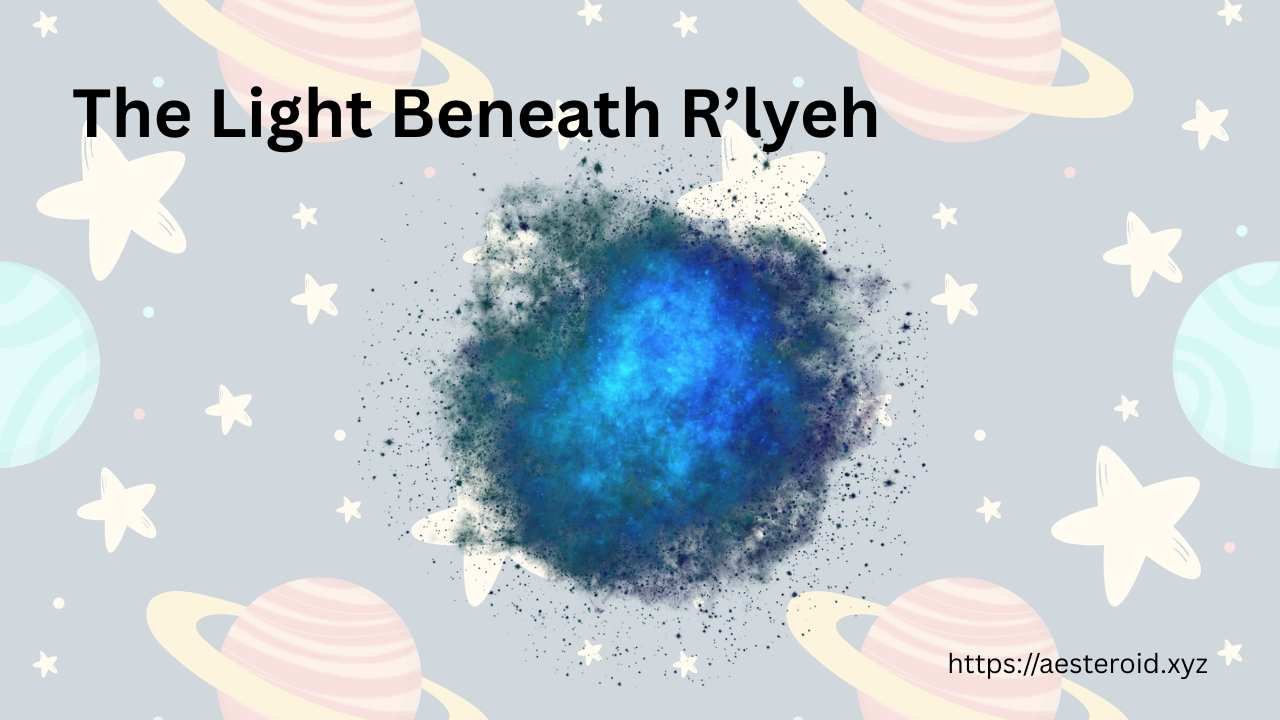
The Light Beneath R’lyeh
I. The Quiet Before
In 2046, an international expedition known as the Vigilant Dawn set sail across the South Pacific. The mission, funded jointly by scientific coalitions and private think tanks, was designed to investigate a tectonic anomaly detected along the ocean floor—an irregular seismic pulse beneath the coordinates long associated with mythic R’lyeh.
Dr. Elira Tamsin, a deep-ocean geologist with a background in comparative mythology, led the team. She had studied the ancient texts—the Ponape Scripture, the R’lyeh Fragments, and even the controversial work of cult archaeologist L. Wyndham. All pointed to this one spot: a submerged plateau that had no business existing on any modern map.
Initial scans returned impossible data. The rock formations below were not natural. They bore angles that defied Euclidean geometry and emitted subtle electromagnetic pulses—like a signal coded in stone. That was when the dreams began.
II. The Pressure of Eyes
By the fifth day, every crew member aboard the Vigilant Dawn reported identical nightmares. They spoke of spirals that turned inward forever, a greenish sky beneath the sea, and a city rising, not by construction, but by memory.
Elira’s dream was clearer than most.
She stood on the ocean floor before a massive black monolith, its surface veined with glowing glyphs. In the distance, something stirred—immense, folded into itself like a thought unfinished. A great eye opened, not in malice, but in recognition. It knew her. Not her name, not her face—but her form. Human. Temporary. Curious.
She woke gasping. Her cabin’s instruments had all shorted out. The clocks blinked nonsense. And from deep within the sea, something knocked—not a sound, but a pressure in the soul. A weight on existence.
III. Rising
Then, it rose.
Not with violence, not with fanfare. The waters simply parted in every direction. The ocean rebelled against the presence breaking its laws.
R’lyeh had surfaced.
The city was vast, grotesque, and magnificent—its towers pulsed with light like breathing lungs. No coral touched it. No algae grew on it. Nature avoided it, and time forgot it. But something within it had not forgotten the world above.
Cthulhu emerged—not as a beast, but as a monument of thought. Taller than mountains, with wings that moved like storms and limbs whose joints defied natural form. His presence disrupted physics itself. Some cameras melted internally. Others recorded frames backwards, or upside down. Time dilated on the deck. One crew member wept for an hour, claiming to have lived a second life in a distant star system, only to be pulled back.
They assumed apocalypse had come.
But no harm came.
Cthulhu stood, and the sea grew still.
IV. The Breach
That night, Elira deciphered fragments of an ancient inscription unearthed by their submersible:
“When the locks of the sphere are undone, the Shapeless will come not to claim—but to erase.”
It was not Cthulhu the ancients had feared, she realized. He was not the destroyer. He was the warden.
And the locks were breaking.
A pulse surged through the trench. Instruments exploded in static. A rift tore open beneath the seabed—vast, circular, radiating absence. It was not a hole. It was an unmaking. From it spilled creatures the human mind refused to shape: figures of negation, the Unshaped, beings from a realm without form or memory. They erased as they moved, devouring logic and replacing it with unreality.
Cthulhu turned to face them.
Not as a conqueror—but as a guardian waking to war.
V. The Battle Beyond Sight
The fight did not take place in space. It happened within the fold of consciousness. The sea shimmered, warped. Stars blinked out as if censored from existence. Cthulhu moved not with motion, but with authority—his gestures encoded in spirals of pressure and light, ancient algorithms written into the crust of Earth itself.
Elira and her crew became spectators of a war older than mankind. The Vigilant Dawn hovered above the trench, caught in the stillness of a shield Cthulhu had formed—a radius of protection shaped by harmonic frequencies.
Every wave of the Unshaped pushed against him. They swarmed, but not in shape. They flooded the concept of structure itself. Where they passed, memory faltered. Crew forgot names, then their limbs, then gravity.
But Cthulhu endured.
His body melted and reformed—his form was not fixed but chosen. A symbol made visible.
Then Elira felt it—a whisper, not through ears, but through the base of her spine. A thought implanted, not imposed.
“This is not your war, but your world.”
She understood. The breach could not be closed by force alone. It had to be remembered shut—sealed by sentient awareness. Humanity had to know the locks once more.
Cthulhu could not do it alone.
VI. The Sharing
Cthulhu showed her.
Not in words, but in visions—fractal histories across timelines: Earths destroyed, saved, altered, forgotten. One world where humanity never evolved. One where the Unshaped swallowed the sun. One where Cthulhu fell, and time itself unraveled like twine in water.
But in this thread—this Earth—there was still hope.
Elira saw it. The locks were not in stone. They were in minds.
Human thought was a gate. Their fear had kept the truth out. But their understanding could now hold it closed.
VII. The Requiem
Cthulhu surged forward, one final time, and sang.
The note could not be heard, but it silenced everything. The Unshaped recoiled—not from pain, but from recognition. They had no place here. This was a world already shaped.
The breach closed.
The rift collapsed into itself. R’lyeh began to sink again, folding gently back into the ocean floor. The sea healed around it, not with fury but with grace.
Cthulhu turned to Elira once more. His form collapsed into light, then sound, then memory. And then he slept.
Not in exile. Not in chains.
In peace.
VIII. The New Dawn
The Vigilant Dawn surfaced weeks later. The crew was intact. Instruments had failed, but memories remained. Not of trauma, but of understanding.
Elira published no photos. No footage. Only a single paper: “On the Protective Structures of Prehistoric Sentience and the Rhetoric of Cosmic Memory.”
Few took it seriously. But those who read it closely found symbols embedded in its margins—spirals, harmonics, and dreams.
The world moved on. But something had changed.
Earth had been seen. Measured. Protected.
Not all old gods were destroyers. Some were keepers of light, misunderstood by those who could only define the unknown as terror.
And beneath the Pacific, in the sunken cathedral of R’lyeh, a thought dreams quietly:
“You are not alone.”


Hi, this is a comment.
To get started with moderating, editing, and deleting comments, please visit the Comments screen in the dashboard.
Commenter avatars come from Gravatar.